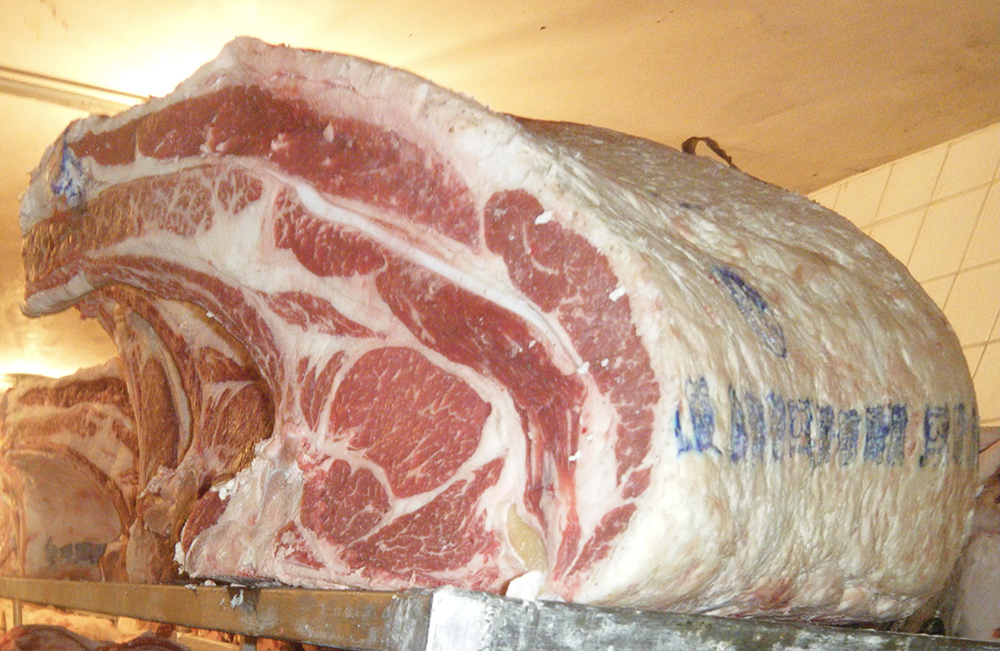By Chef Joseph Massaglia
A few weeks ago I had three dear friends in the studio with me on my radio show, Joe’s Table for Two. Dan Fedele, who owned Fedele’s Restaurant in Margate; Doug Fraser, who has been in the hospitality and food business for many years, including owning the Atlantic City Country Club and the Flanders Hotel among others; and Al Shettig, whose family owned and operated Busch’s restaurant in Sea Isle City, which was famous for its She Crab Soup.
Among the many topics we covered the subject of prime beef came up, and we had quite a discussion about what is and isn’t prime. Anyone who knows me, or listens to my radio show knows, I’ve never met a steak I didn’t like, especially a dry-aged prime rib eye,
Prime beef, the highest quality of beef rated by the United States Department of Agriculture (USDA), is produced from young, well-fed cattle, has abundant marbling, and is mostly sold in restaurants and hotels. Most of the beef you find in supermarkets today is labelled Angus beef, the name of the breed of cattle which originated in Scotland, and is rated “choice” by the USDA – the second level in the USDA’s grading scale. Not all Angus beef is prime beef. Real prime beef is a rarity – less than three percent of all selected, inspected and approved meat in the United States is rated prime.
And my favorite meat is not just prime beef, but dry-aged prime beef. But why age beef?
Well, dry or wet aging improves the rich flavor and makes beef more tender and therefore more delicious – and, of course, more expensive.
Dry aging is the process by which large cuts of beef are hung on racks in a meat locker where the temperatures are kept between 38 and 40° Fahrenheit, a specific humidity level is maintained, and air is constantly circulated. They are aged four to six weeks before being trimmed and cut into steaks. There also is wet aging, where the meat is first cryovaced, a process where the meat is placed in special packaging and the air removed by vacuum, and then aged several weeks.
The dry aging process requires high grade quality meat with a high fat content so that as the beef ages and moisture evaporates from the meat, the meat shrinks and the flavor becomes more concentrated in the muscle. The meat also becomes more tender because proteins in the muscle break down. It’s an expensive process due to the quality of meat needed at the start, the large physical area required to hang the carcasses, the need to constantly monitor the temperature of the storage room, and the time involved. That’s why you find it mostly in steak houses or butcher shops, and occasionally at a high-end grocery store.
I don’t recommend trying to dry age individual steaks at home, even though several well-known websites have instructions to do so. In the commercial process experts are constantly monitoring the beef to make sure there is no chance of spoilage or off-flavors. That’s because if the beef is not pulled or removed from the locker at the right time the surface mold develops, which is critical to the process, the flavor of the meat will be negatively affected.
My concern is that unlike the carefully monitored commercial lockers which meet stringent quality and safety guidelines, your refrigerator contains many different types of food with potentially higher bacteria counts in a non-controlled higher temperature setting.
In a home refrigerator the temperature changes every time you open the door, the humidity is high, there is no air circulation, there may be some spoiled item in the frig which could contaminate the steak, and the chance of your having spoiled meat which will make you sick is very high. So, please enjoy your dry aged steaks at a great steak house, or cook at home those you purchase from a reputable butcher or grocery store.
And, here’s the way I cook steaks at Mama Mia’s Restaurante and at home: Buy the best quality steak you can afford, season it with kosher salt and pepper, and brush with melted butter. Heat a cast iron skillet over medium-high heat (or on the grill) until the pan is nice and hot. Sear the steak on one side until a beautiful crust develops, turn, repeat on the second side, and cook to your desired temperature. It doesn’t get much better than this.
Be well, stay safe, and support your local restaurants now that they are open.
Buon Appetito!
Joe’s Table for Two radio show airs Saturday mornings from 10 a.m. to 1 p.m. on WOND 1400 AM. Website: joestablefortwo.com. Facebook: Joe’s Table for 2 and Eat at Joe’s EHT. Contact Joe: joestablefortwo@gmail.com.






